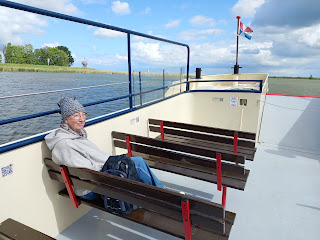Time for another short break before Covid perhaps puts a stop to it again. This one was close to home - in Lancashire. A local train from Alderley Edge on Friday 22nd October took me to the meeting point for the start of the holiday - Wigan!
Please click on any picture for a larger image.
Friday
First stop, Martin Mere Wetland Centre.. and otters (and tea & Sandwiches!)
Quarry Hunslet 'Irish Mail', ex-North Wales slate quarry loco (most named after race horses) at the West Lancashire Railway.
We saw and heard more skeins of arriving geese, in their hundreds, here, at Hesketh Bank on the Lancashire coast than at Martin Mere - most impressive.
Our coach took us to book in to our hotel for the next four nights, the Mercure Dunkenhalgh (The Dunk!) near Blackburn.
Our coach at our hotel
Saturday
You don’t often find a western engine in Lancashire. Gloucester Warwickshire Railway’s ‘Dinmore Manor’ hired in for last weekend’s gala was still earning its keep a week later on the East Lancashire Railway, here backing out of the headshunt and about to run round its train at Rawtenstall.
Earlier we had visited MoSI museum in Manchester, very well known to me as I was steam loco crew volunteer there for a few years before that railway’s demise.. Sadly, it was mostly closed for refurbishment (and no doubt, more dumbing down).
Dinmore Manor
Sunday
This is the Embsay & Bolton Abbey Railway… Not much to say about this.... A smart little industrial loco and a short, slow, but quite pleasant ride in ex-BR Mk1s.
There wasn't room for us all to take the return journey on the train so some of us returned in our coach. On the way we stopped to photograph the train.
Our coach took us on to Keighley for the Keighley & Worth Valley Railway
A Midland 4F on the Keithley & Worth Valley Railway. Here we had an excellent private shed tour, and enjoyed steam up and down the valley with a superb real ale or two available on draught in the buffet car. Heaven!
Lunch on the move!
The 4F has a drink at Keighley
We enjoyed a very informative visit to Haworth sheds. They've got a Pacer in there as well as far more interesting stuff!
A lovely S160 seen on the shed tour (we have three of these on the Churnet Valley Railway). This one they call ASBO, as they can't get it to behave properly. I'm sure the CVR could advise!
The 'Green Dragon', star of the original 'Railway Children' film which, like its sequel, was made on the railway.
This Class 37 was used in a TV documentary about The Great Train Robbery, masquerading as the Class 40 involved in that heist
This is 'Vulcan', a one-off diesel electric shunter owned by English Electric (which no longer exists!)
This Ivatt Class 2 MT locomotive re-opened the line in 1968
A visiting Class 26 from Barrow Hill Roundhouse
Our host in the orange hi-viz
This Black Five is owned by Ian Riley and had just returned from a summer season on the 'Jacobite' services in Scotland (Harry Potter and all that)
Also back from its holidays was double-chimney Jubilee, 'Bahamas'. It had spent the summer and autumn working steam specials mostly in the South West of England.
'Bahamas' flight deck
A lovely spiral staircase in Haworth shed
This loco is on the railway's wheel drop. This enables locomotive (and coach and wagon) wheels to be dropped out of the frames for maintenance of the wheels or horn guides, without having to lift the vehicle.
It's that 4F again! Time for another ride
The end of the day at Oxenhope. The gentle hiss of gas lamps complements the ticking of the clock as they illuminate the booking hall after the last train has gone, and as we wait for our stragglers before returning to our coach for the drive back to the hotel.
Monday
Starting at Skipton we travel on on the ‘Staycation Express’, an ex-GWR HST set on the Settle Carlisle in 1st class. David settles into his 'armchair' in the 1st class Mk3 and looks forward to his Cumberland sausage bap and cup of tea.
A 1st class Mk3 coach is undoubtedly the best riding and most comfortable stock there has ever been on a British railway. The big windows, perfectly aligned with the comfy leather ‘armchair’ seats were just the job to observe the fells.
As we pass Hellifield Junction this freight train (Leeds to Arcow Quarry at Horton-in-Ribblesdale) awaits its path behind us.
Pen-Y-Ghent to our right
Approaching Ribblehead Viaduct, photographed through an open vestibule door windows with strict instructions not to lean out. Those stickers are cheaper than NR maintaining the trackside vegetation which brushes the train at times.
Many parked cars, walkers, and train photographers at Ribblehead
We were very lucky with the weather.....
So often one can't see this wonderful scenery for the mist and rain, but not today
Dent Cottages, available as lineside holiday lets
Dent Dale
Whernside
One of the two HST power cars (43059) at Appleby, where we left the train for a trip through the dales in our coach to Hawes, then on back to Ribblehead for lunch in a pub.
43059 again
Back in our coach, off to Hawes
We stopped off at the Hawes Countryside Centre, dodging the showers (and no, there's no railway at Hawes any more - just a loco and a couple of ex-BR Mk1s).
On by coach to Ribblehead - the young river Ribble
Ribblehead Viaduct from the our coach
After a late (very late!) lunch our coach took us on to the ‘highlight’ of the holiday, Blackpool Illuminations seen from our privately-hired double deck tram.
Blackpool Illuminations form our tram
After the tram ride from Bispham to South Pier and back up to North Pier, Stephen, our tour guide, briefs us on where to meet our coach when it's time to return to the hotel (that'd be at 9pm, after we'd found some late supper and a drink, and enjoyed a short on-foot look at this - tackier than I remember it - resort).
Tuesday
We travelled by local train from Rishton to Bamber bridge from where our coach took us to Leyland for the Commercial Vehicle Museum. Above is Rishton's heavily-supported 'listing' signal box!
Some Leyland Commercial Transport Museum exhibits.
From here, it was coach to Preston for trains home about lunch time. A Northern train to Stockport, then another to Wilmslow for me.
.


































































































